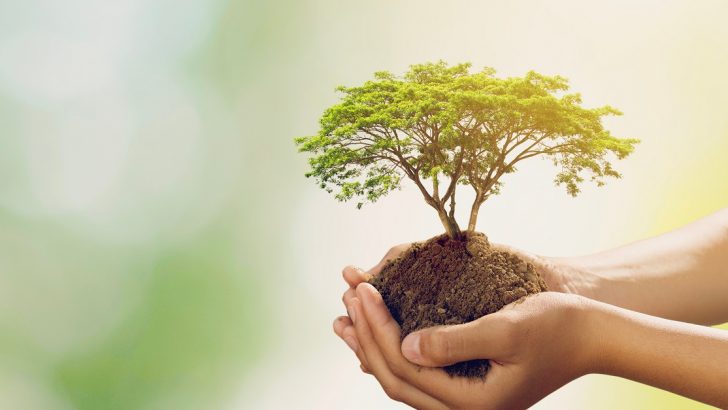Chai Brady hears about parenting and being green
Being environmentally friendly is something that many people are striving for, particularly in recent years as hundreds of studies and reports are conducted and published from reputable universities, the UN, EU and the Church. Pope Francis has given the drive to be eco-friendly fresh impetus with his encyclical on the environment, but how practical is it for families to change their routines?
Family life can be hectic, if there’s a new baby on the way, planning how to cut down on the mounds of waste generated by child-rearing might be the last question on a couple’s mind.
For Catherine Devitt, who worked as the Environmental Justice Officer with the Jesuit Centre for Faith and Justice (JCFJ), when she found out there was a baby on the way being green was certainly on her mind.
Although no longer working with the JCFJ much of Catherine’s work involved looking at how the Jesuits in Ireland can improve their environmental footprint, so when it comes to her home life Catherine most certainly practices what she advises.
One of the most important challenges is boycotting disposable nappies which are known to be both environmentally and economically unfriendly. They can put a strain on the planet as many are put in landfills or burnt, and can also take a toll on family finances.
Advice can present itself closer to home. Catherine’s mother used cloth nappies in the 1980s before the disposable alternative became mainstream in Ireland, she was on hand to offer her guidance.
For those who are looking for resources and help to find first-hand information about cloth nappies there are many social media groups that have been established for these discussions.
Mother of one-year-old Rowan, Catherine says baby clothes are something that quickly become unusable.
Speaking to The Irish Catholic she says: “They’re growing at such a fast rate and we certainly found that parents are very willing to give you clothes that you no longer need.
“We found that there’s actually no need to buy new clothes and that there is plenty of alternatives, whether through charity shops or again online, there are so many groups where people are willing to give clothes that they no longer need.”
Buying new clothes that will only be used for a short stint isn’t worth the environmental impact, according to Catherine, but it is also a way of being financially savvy as baby clothes can be quite expensive. This is the same for cloth nappies which can be more expensive than their disposable counterparts initially, but in the long term they are a good investment.
Breastfeeding is another way of doing this, although this isn’t an option for some mothers, Catherine says it is hugely beneficial in cutting down plastic, bypassing intensive farming and the emissions associated with formula, and for your pocket.
“Every maternity hospital should be promoting breastfeeding for mothers,” she says, adding that there should be no stigma associated with it.
There are arguments that in order to save the planet people need to reduce the amount of children they have, or even stop altogether as larger populations create more waste and emissions.
One of the most important challenges is boycotting disposable nappies which are known to be both environmentally and economically unfriendly.”
Catherine disagrees saying: “Some people comment that we have an overpopulation problem and we should be talking about some people not having children and so on, I think it’s important to really think about how we want to raise our kids and what’s the type of world that we want to leave our children, so we try and make a conscience effort of being outdoors with our child.
“I think as well children are really aware of these issues now, they’re talking about environmental issues in school. They’re probably more eco-conscience than their parents and I think therefore as parents it’s really important to talk about these issues and live more sustainably in our homes.”
With a five-year-old daughter Joanne McGarry, Campaigns Manager with Trócaire, faces different challenges when it comes to imbuing a respect for nature into her family home.
“I try and give her as many messages as I can about the need to be kinder to the environment,” she says.
“There’s lot of things we do at home to try and get that message through. I take it very seriously, I do my best but I’m not perfect by any means.”
It doesn’t end there, Single-use plastics, which have long been the subject of condemnation, are not welcome.”
Focusing on children her daughter’s age she says it’s important to “make them mindful of conserving water and electricity. So she would be going around making sure the taps are turned off”.
“We try and grow some food in our garden, it’s nothing major but it’s nice for her to see where food comes from and that helps us with the messaging about food waste. I’m actually quite strict about it, I would encourage her to finish her meals.”
It doesn’t end there, Single-use plastics, which have long been the subject of condemnation, are not welcome. One of the most famous cases that highlighted the issue is a giant island of rubbish – which is mainly plastic – floating in the Pacific Ocean. Known as the ‘Great Pacific Garbage Patch’ it’s reported to measure 1.6 million square kilometres and continues to grow exponentially each year. It was created by plastic being thrown into oceans and streams which is then carried by one of the ocean’s five major currents.
Joanne says: “We do our best to reduce plastic that we buy first of all, there’s a lot of plastic stuff out there for kids.”
“Some of it is reusable which is fine but then there’s a lot of very single-use stuff like some toys, straws and packaging. We have paper straws and stainless steel straws and we try and minimise the plastic that we buy. She’s [her daughter] getting those messages. She has her own – like most kids now – water bottle that’s refilled. We wouldn’t buy any plastic bottles.”
Focusing on the concept of ‘fast fashion’ and the negative impact it has on the environment she says: “Some families would be lucky enough to have hand-me-downs coming from all over the place, I’m lucky enough to have a friend who gives me a lot of her daughter’s clothes and we do our best not to buy clothes that are very disposable.
“Some people don’t have the opportunity to do this but if you’re in a parents group or a mothers group or a toddlers group there’s lots of passing on of baby things, which can be very expensive. It works both ways because the person passing it on is delighted to be getting rid of it in one sense and delighted to see it getting another wearing, and the person receiving it is delighted because they don’t have to go out and buy it.”
Changing habits to reduce waste and to create an environment in a household that respects and works toward sustainability can be difficult, but according to some eco-mothers it isn’t impossible and may even be convenient: both for your wallet and the earth.


 Chai Brady
Chai Brady
